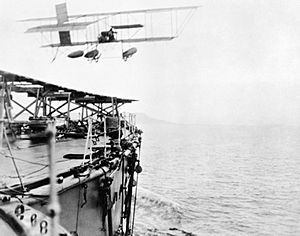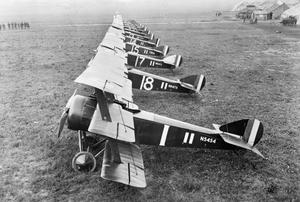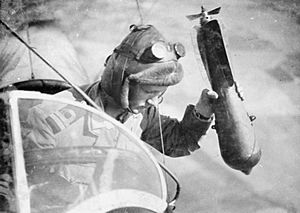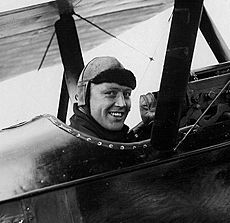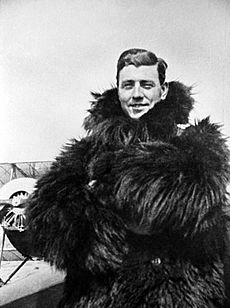Royal Naval Air Service facts for kids
The Royal Naval Air Service (RNAS) was the air branch of the Royal Navy. It was managed by the Admiralty's Air Department. The RNAS officially existed from July 1, 1914, until April 1, 1918. On that date, it joined with the British Army's Royal Flying Corps to create the Royal Air Force (RAF). The RAF was the world's first independent air force.
Later, the Fleet Air Arm took its place. This group first included RAF units that flew from ships. Over time, it became a separate unit, much like the original RNAS, especially by the time of the Second World War.
Contents
In 1908, Captain Reginald Bacon suggested building a large airship. He wanted it to be like the German Zeppelin. This idea was approved in 1909. Captain Murray Sueter became the first Royal Navy officer to work on a naval air project.
On June 21, 1910, Lieutenant George Cyril Colmore became the first trained pilot in the Royal Navy. He paid for his own training!
In November 1910, the Royal Aero Club helped the Navy. A member, Francis McClean, gave the Navy two planes for training. The club also offered instructors and their airfield at Eastchurch. The Navy accepted this offer. On December 6, the Navy asked for unmarried officers to apply. They also needed to pay club fees. The airfield became the Naval Flying School. Four officers were chosen: Lieutenant C. R. Samson, Lieutenant A. M. Longmore, Lieutenant A. Gregory, and Captain E. L. Gerrard.
On April 13, 1912, the Royal Flying Corps (RFC) was officially formed. It included the Navy's small air group and the Army's Air Battalion. The RFC had two parts: the Military Wing for the Army and the Naval Wing for the Navy. Commander C. R. Samson led the Naval Wing.
A Central Flying School was set up at Upavon to train pilots for both the Navy and Army. It opened on June 19, 1912. The Naval Wing could also do experiments at its school in Eastchurch.
In 1912, Captain Murray Sueter became the Director of the new Air Department at the Admiralty. He was in charge of "all matters connected with the Naval Air Service."
In September 1912, four naval seaplanes took part in Army training exercises. By 1913, plans were made to build a seaplane base and an airship base. Aircraft also trained with the Royal Navy for the first time. They used the ship Hermes as a seaplane carrier.
On July 1, 1914, the Admiralty officially made the Naval Wing of the Royal Flying Corps part of the Royal Navy. This new group was called the Royal Naval Air Service.
The RNAS During World War I
When First World War started in August 1914, the RNAS had 93 aircraft, six airships, two balloons, and 727 people. The Navy had twelve airship stations around the coast of Britain. On August 1, 1915, the Royal Naval Air Service officially came under the control of the Royal Navy.
The RNAS did more than just naval work. It also had fighter squadrons on the Western Front. They even had a special bombing force. Sometimes, there was competition between the Navy and Army over planes. For example, the RNAS had to give some of its planes to the Army because of contracts. The RNAS often got newer planes like the Sopwith Pup, Sopwith Triplane, and Sopwith Camel before the Army did.
On April 1, 1918, the RNAS joined with the RFC to form the Royal Air Force. At that time, the RNAS had 55,066 officers and men. It also had 2,949 aircraft, 103 airships, and 126 coastal stations.
RNAS squadrons became part of the new RAF. For example, No. 1 Squadron RNAS became No. 201 Squadron RAF.
The Royal Navy got its own air service back in 1937. It was called the Fleet Air Arm. This group handled aircraft that flew from ships. In 1952, it went back to its original name, the Fleet Air Arm.
What the RNAS Did
The RNAS had several important jobs. They scouted for the fleet, patrolled coasts for enemy ships and submarines, and attacked enemy areas on land. They searched a huge area of the Channel and North Sea for German U-boats. In 1917, they spotted 175 U-boats and attacked 107. These attacks didn't sink many submarines, but they helped the Navy find and fight them.
The RNAS also provided armored cars during a retreat in 1914. Later, RNAS squadrons went to France to help the RFC. The RNAS was even in charge of defending London from air attacks. This led to their raids on German airship bases, even far from the sea.
Before planes could easily land on ships, the RNAS used seaplanes. These planes took off and landed on water. Special ships called seaplane tenders were built to support them. From these ships, the RNAS launched a raid on German Zeppelin bases on Christmas Day 1914. This was the first attack by British planes from ships. A network of coastal air stations was also built.
Famous People in the RNAS
Many brave and skilled people served in the RNAS:
- John Alcock – a pioneer in aviation.
- Henry Allingham – a mechanic and the last surviving member of the RNAS.
- Richard Bell-Davies – awarded the Victoria Cross for his bravery.
- Raymond Collishaw – the top RNAS ace with 60 victories in air battles.
- Roderic Dallas – a commanding officer and ace with over 32 victories.
- Edwin Harris Dunning – the first person to land a plane on a moving ship in 1917.
- Robert A. Little – Australia's top scoring ace of World War I.
- Charles Rumney Samson – led the first armored car units.
- Barnes Wallis – an engineer famous for designing the "bouncing bomb" in World War II.
- Reginald Alexander John Warneford – awarded the Victoria Cross.
Ships Used by the RNAS
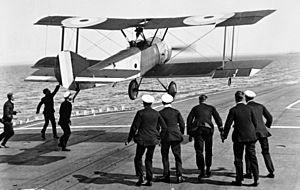
The RNAS used many different ships, often converted from other uses:
- HMS Hermes: An old cruiser turned into a seaplane carrier.
- HMS Empress, HMS Engadine, HMS Riviera, HMS Vindex, and HMS Manxman: These were all converted Channel ferries. They launched the first British naval air attack in 1914. HMS Vindex was the first ship to launch a wheeled aircraft.
- HMS Ben-my-Chree: A fast ferry that became a seaplane carrier. It was used in the Gallipoli Campaign. Its planes made the first successful aerial torpedo attack against ships.
- HMS Ark Royal: Also served at Gallipoli. It was renamed Pegasus in 1934.
- HMS Campania: A large former passenger liner. It had a take-off ramp, but it wasn't long enough for wheeled planes.
- HMS Manica: A converted cargo ship with the Navy's first observation balloon.
- HMS Nairana: A converted passenger ship with a take-off ramp.
- HMS Furious: A battle cruiser that was changed to have a flying-off deck. It was later rebuilt and served in World War II.
- HMS Argus: Started as an Italian liner. It was finished as a carrier with a full flight deck in 1918.
RNAS Armoured Car Section
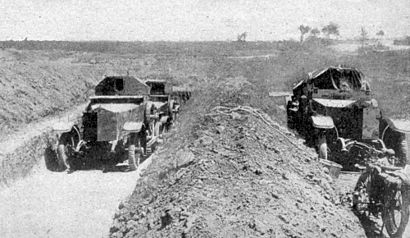
The RNAS also had its own land forces! These were called the RNAS Armoured Car Section. They used Rolls-Royce Armoured Cars. Commander Charles Rumney Samson led this group.
At first, their cars were not armored. They were used to keep communication lines safe and pick up aircrew who landed in enemy territory. But Samson saw their potential. He put a machine gun on one car and added metal plates to protect his vehicles. These new armored cars were very effective in raids against the Germans.
By November 1914, this section grew into the Royal Naval Armoured Car Division (RNACD), with 20 squadrons. As trench warfare became common, the armored cars couldn't be used on the Western Front. So, they were sent to other areas like the Middle East, Romania, and Russia. In 1915, the Army took over control of armored cars.
However, the RNAS's experience was not lost. One RNAS squadron continued to develop armored vehicles for land battles. The people from this group later helped create the first tanks.
RNAS Bases and Stations
- Aldeburgh, Suffolk
- Atwick, Yorkshire
- Bacton, Norfolk
- Bayfield, Norfolk
- Burnham-on-Crouch, Essex
- Calshot, Hampshire
- Chelmsford, Essex
- Chingford, Essex
- Clacton-on-Sea, Essex
- Covehithe, Suffolk
- Cranwell, Lincolnshire
- Detling, Kent
- Dover (Guston Road), Kent
- Eastbourne (St Anthony's Hill), East Sussex
- Eastchurch, Kent
- Fairlop, Essex
- Felixstowe (Landguard Common), Suffolk
- Felixstowe Dock, Suffolk
- Goldhanger, Essex
- Gosport, Hampshire
- Grain and Port Victoria, Kent
- Hainault Farm, Essex
- Hendon Aerodrome, Middlesex
- Hickling Broad, Norfolk
- Hornsea Mere, Yorkshire
- Lee-On-Solent, Hampshire
- Narborough, Norfolk
- Newlyn, Cornwall
- Pulham St Mary, Norfolk
- Scarborough, Yorkshire
- Treligga, Cornwall
- Walmer, Kent
- West Drayton (Stockley), Middlesex
- Widford, Essex
- Wormwood Scrubs, London
- Yarmouth, Isle of Wight
Scotland
- Caldale, Orkney
- Cromarty, Ross & Cromarty
- East Fortune, East Lothian
- Houghton Bay, Orkney
- Loch Doon, Ayrshire
- Longside, Aberdeenshire
- Scapa Flow, Orkney
- RAF Turnhouse, Edinburgh
Wales
- Fishguard, Pembrokeshire
France
Eastern Mediterranean
- Imbros, Turkey
- Moudros, Greece
- Stravos
- Thasos, Greece
Elsewhere
How the RNAS Was Organized
Unlike the RFC, the RNAS was not organized in one central way. This meant there could be several "No. 1 Squadrons." Even wing numbers changed, so it can be tricky to track them.
At the start of the war, there were three wings: 1, 2, and 3. More wings were formed as the war went on.
- Wing 1 was active on both sides of the English Channel in 1914.
- Wings 2 and 3 went to the Dardanelles for the Gallipoli Campaign. Wing 3 was later combined with Wing 2.
- Wing 3 was reformed in 1916 for strategic bombing, but it was disbanded in 1917.
- Wings 4 and 5 grew from Wing 1. Wing 4 focused on fighters, and Wing 5 on bombing.
- Wing 6 was formed to patrol the Adriatic Sea. By 1918, it expanded to Malta.
Squadrons serving in France were numbered from 1 to 17. When the Royal Air Force was formed in 1918, they became RAF squadrons 201 to 217.
Squadrons in the Eastern Mediterranean were given letters (A to G, and Z).
- In 1918, Squadron A became RAF Squadron 222.
- Squadron B became RAF Squadron 223.
- Squadron C became RAF Squadron 220.
- Squadron D became RAF Squadron 221.
- Squadron Z was given to the Royal Greek Navy.
RNAS Ranks
Officer Ranks
In the RNAS, pilots and observers had special roles in addition to their normal Royal Navy ranks. They wore badges that showed their role instead of their rank. These badges had regular Royal Navy cuff stripes. Above the stripes, pilots had an eagle, and observers had a winged letter "O."
Squadron Commanders and Squadron Observers with less than eight years of experience had two stars above their badges. Flight Commanders and Flight Observers had one star.
| Rank group | General/flag officers | Senior officers | Junior officers | Officer cadet | ||||||||||||||||||||||||||||||||
|---|---|---|---|---|---|---|---|---|---|---|---|---|---|---|---|---|---|---|---|---|---|---|---|---|---|---|---|---|---|---|---|---|---|---|---|---|
(1914–April 1918) |
 |
 |
 |
|
 |
|||||||||||||||||||||||||||||||
| Wing Captain | Wing Commander |
Squadron Commander (more than 8 years seniority) |
Flight Sub-Lieutenant |
|||||||||||||||||||||||||||||||||
| Wing Observer | Squadron Observer (more than 8 years seniority) |
Observer Sub-Lieutenant | ||||||||||||||||||||||||||||||||||
When the RNAS joined the Royal Flying Corps to form the Royal Air Force in 1918, some RNAS pilot roles became the basis for new RAF officer ranks, like Wing Commander and Flight Lieutenant.
Other Ranks
The RNAS also had specific ranks for its non-officer members, introduced in 1914.
See also
- List of aircraft of the Royal Naval Air Service
- Number 2 Armoured Car Company RAF
- Category:Royal Naval Air Service aviators



